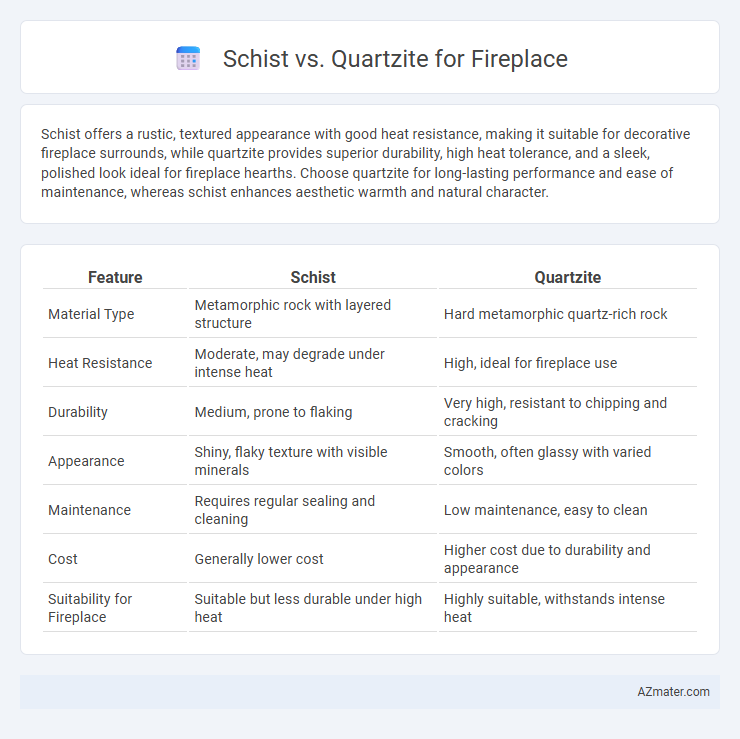Schist offers a rustic, textured appearance with good heat resistance, making it suitable for decorative fireplace surrounds, while quartzite provides superior durability, high heat tolerance, and a sleek, polished look ideal for fireplace hearths. Choose quartzite for long-lasting performance and ease of maintenance, whereas schist enhances aesthetic warmth and natural character.
Table of Comparison
| Feature | Schist | Quartzite |
|---|---|---|
| Material Type | Metamorphic rock with layered structure | Hard metamorphic quartz-rich rock |
| Heat Resistance | Moderate, may degrade under intense heat | High, ideal for fireplace use |
| Durability | Medium, prone to flaking | Very high, resistant to chipping and cracking |
| Appearance | Shiny, flaky texture with visible minerals | Smooth, often glassy with varied colors |
| Maintenance | Requires regular sealing and cleaning | Low maintenance, easy to clean |
| Cost | Generally lower cost | Higher cost due to durability and appearance |
| Suitability for Fireplace | Suitable but less durable under high heat | Highly suitable, withstands intense heat |
Introduction to Schist and Quartzite
Schist, a medium-grade metamorphic rock, features pronounced foliation and a sparkling appearance due to abundant mica minerals, making it a decorative choice for fireplace surrounds. Quartzite forms from quartz-rich sandstone subjected to intense heat and pressure, resulting in a dense, hard stone with excellent heat resistance and durability ideal for fireplaces. Both stones offer unique aesthetic and functional qualities, with schist providing textured elegance and quartzite delivering strength and longevity in fireplace applications.
Geological Composition of Schist
Schist, a metamorphic rock characterized by its foliated texture and abundant mica minerals, contrasts with quartzite's predominantly quartz composition. The geological composition of schist includes varying amounts of mica, chlorite, and quartz, providing a layered structure that can impact its heat resistance and durability in fireplace applications. This mineral composition allows schist to withstand thermal cycles well but may result in increased susceptibility to spalling compared to the denser, non-foliated quartzite.
Geological Composition of Quartzite
Quartzite, a metamorphic rock formed from quartz sandstone, consists primarily of tightly interlocking quartz grains, giving it exceptional hardness and durability ideal for fireplaces. Its dense composition resists heat and weathering, maintaining structural integrity under high temperatures. Unlike schist, which contains flaky mica minerals prone to splitting, quartzite offers a more uniform and non-foliated texture, ensuring safety and longevity in fireplace applications.
Appearance and Color Variations
Schist for fireplaces offers a distinctive layered texture with a natural shimmer, showcasing earthy tones such as gray, green, and brown that create a rustic and warm ambiance. Quartzite displays a more consistent and smooth finish, featuring a broader color range from white and gray to subtle pinks and blues, lending a sophisticated and elegant look. Both materials provide durable surfaces, but their color variations and textures cater to different aesthetic preferences for fireplace design.
Heat Resistance and Fire Safety
Quartzite offers superior heat resistance and fire safety compared to schist, making it a more reliable choice for fireplace surrounds. Its dense, non-porous structure withstands high temperatures without cracking or discoloration, ensuring long-lasting durability and minimal maintenance. Schist, while aesthetically pleasing, is more prone to heat-induced damage due to its layered composition and lower thermal tolerance.
Durability and Longevity
Quartzite offers superior durability and longevity compared to schist, making it an excellent choice for fireplace surrounds exposed to high heat and frequent use. Its natural hardness and resistance to heat, scratches, and weathering ensure it maintains structural integrity over time, unlike schist which is softer and more prone to flaking and wear. Quartzite's dense composition also minimizes porosity, reducing the risk of staining and damage from soot or moisture near fireplaces.
Maintenance and Cleaning Requirements
Schist fireplaces require regular sealing to prevent staining and moisture damage due to their foliated texture and natural cleavage planes, which can trap dirt and soot. Quartzite, being denser and harder, offers superior resistance to scratches and staining, allowing for easier cleaning with mild soap and water without frequent sealing. Both materials benefit from avoiding acidic or abrasive cleaners to maintain their surface integrity and aesthetic appeal over time.
Cost Comparison: Schist vs Quartzite
Schist fireplaces generally cost less than quartzite due to the abundance and lower processing requirements of schist slabs, with prices averaging between $30 to $60 per square foot compared to quartzite's $50 to $100 per square foot. Installation costs for both materials are similar, though quartzite may require more specialized handling because of its hardness and density. The long-term investment value of quartzite often outweighs the initial higher expense, given its superior durability and resistance to heat and scratching.
Aesthetic Appeal for Fireplace Design
Quartzite offers a sleek, glassy surface with subtle color variations, lending a modern and elegant aesthetic to fireplace designs. Schist showcases a distinctive, layered texture with sparkling mica flakes, creating a rustic and visually dynamic focal point. Both stones enhance fireplace appeal, with quartzite emphasizing smooth sophistication and schist providing natural, textured charm.
Pros and Cons of Schist vs Quartzite for Fireplaces
Schist offers a unique, layered texture and natural shimmer, making it an attractive choice for fireplace surrounds, but it is softer and more prone to chipping compared to quartzite. Quartzite provides exceptional hardness and heat resistance, ensuring durability and low maintenance, while its more uniform appearance may lack the distinct character of schist. Both stones are heat-resistant, but quartzite's superior density makes it more resistant to cracking under thermal stress, whereas schist requires careful sealing to prevent moisture absorption and staining.

Infographic: Schist vs Quartzite for Fireplace
 azmater.com
azmater.com